|
| |
Issue no. 56 - March-May 1994
pdf
 version of this Issue version of this Issue
|
There is much information in this issue that is valuable
and useful. Online readers are reminded, however, that treatment guidelines and health
care practices change over time. If you are in doubt, please refer to
WHO's up-to-date Dehydration Treatment
Plans.
|
Pages 1-8 Dialogue on Diarrhoea Online Issue 56 - March-May
1994
|
DDOnline Dialogue
on Diarrhoea Online Issue no. 56 March-May
1994  Page 1 2
Page 1 2
Making weaning safer
|
Good
food hygiene is very important during weaning. Weaning - the gradual introduction of foods
other than breastmilk - can be a risky time for infants. They are losing the benefits of
breastmilk and are exposed to food-borne germs for the first time. This means that safe
preparation and storage of food should be a priority during weaning. After 4-6 months of age, infants need more food and nutrients in order to grow well.
Because of their small stomachs they need to have as many as 5-6 small meals a day. Ideally, infants should be given freshly prepared food at every meal. This is because
storing food at room temperature causes bacteria in the food to multiply rapidly.
|
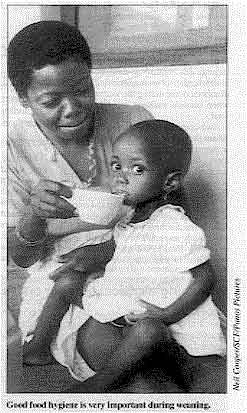 |
However, we should recognise that many families do not have the resources to cook fresh
food five or six times a day. Many women are already overworked, and advice which adds to
their workload is not likely to be welcomed. Lack of time and scarce or expensive fuel
means that often families cook in bulk and store food for later meals. If food is stored between meals it is important that storage methods are safe. Food
should be covered so it will not be contaminated by flies or dust. It should be kept cool
to prevent germs breeding. Most families do not have a refrigerator, but many do have
traditional ways of preserving and protecting food. In some societies food is stored in
containers in running water or in porous pots standing in water to keep the food cool.
Sometimes food is kept in baskets and hung from the ceiling out of reach of insects and
rodents, and where wind will keep it cool. Some traditional preparation methods, such as fermentation or the production of curd
from milk. protect food from germs and delay spoilage. One key action - heating food thoroughly - can destroy most germs in food that cause
diarrhoea. It is particularly important to reheat food that has been stored from an
earlier meal before re-serving it. This issue of DD looks at what can be done to improve food hygiene taking
account of the constraints faced by families. It also describes improved cookstoves that
allow families to practise good hygiene - thorough heating before serving food - on
limited budgets. It is important that health workers and educators find out about local food practices,
especially traditional practices that improve food hygiene, and work with communities to
identify, ways of reducing the risk of diarrhoea from contaminated food. William Cutting and Katherine Elliott
|
In this issue:
- Golden rules for safe food preparation
Page
3
- Cookstoves that use less fuel
Page
5
- How to help malnourished children recover from diarrhoea
Page 7
|
|
DDOnline Dialogue
on Diarrhoea Online Issue no. 56 March-May
1994  1 Page 2 3 1 Page 2 3
Facts about food hygiene
Safe preparation and storage of food is crucial
to good health. Up to 70 per cent of all diarrhoea episodes are caused by germs that can
be carried in food and swallowed. It is estimated that improvements in food hygiene could
decrease the incidence of diarrhoea between 15 and 70 per cent. Food can be contaminated in many different ways, including through contact with the
following: human faeces used as fertiliser; unclean water; dirty hands of food handlers;
dirty utensils or containers; and animals and insects. It is likely that fewer germs are required to cause illness when swallowed in food,
rather than in water, because food may protect the germs from acid in the stomach. In addition, when food is stored at warm temperatures, small harmless numbers of
bacteria can multiply to dangerous levels. In most countries more episodes of bacterial
diarrhoea occur during the warmer months when bacteria multiply rapidly in stored food. Two common mistakes significantly increase the risk of food contamination:
- preparation of food several hours before eating, then storing it at warm temperatures,
which encourages growth of bacteria
- insufficient cooking or reheating of food.
If food is cooked thoroughly and eaten as soon as it is cool enough to eat. then most
food-borne diarrhoea can be prevented. It is particularly important to avoid storing and
re-serving food to infants who are most vulnerable to infection (see="#Weaning">box
below). However, if food needs to be stored it should be kept as cold as possible, preferably
in a refrigerator. All stored food should be reheated until it is thoroughly hot before
serving. The survival and growth of harmful germs can also be reduced by changing the food's
characteristics to make it more difficult for germs to reproduce, for example increasing
the acid level or reducing the moisture content. Fermentation, a traditional method of
food preparation, increases the acidity of food in order to delay spoilage. (See DD40 for more information.)
FOOD HYGIENE
means preparing, handling and storing food in ways that reduce the
transmission of germs, including those that cause diarrhoea.
|
Methods to stop contamination of food may sound straightforward, but
putting them into practice is not always easy. For many families, food preparation is
affected by the following factors:
- Poor sanitation
Unsafe disposal of faeces allows faecal germs to spread to food, water, food
preparers'
hands, food containers and utensils.
- Inadequate supplies of water
Unless people have access to a plentiful supply of water, they are unlikely to use scarce
water for hygiene purposes such as handwashing.
- Lack of safe water
Contaminated water that is used to prepare weaning food without being boiled can cause
diarrhoea.
- Shortage of fuel
When adequate fuel is not available or is expensive, families often cook large quantities
of food and store it for the next meal. Refrigerators may be beyond the means of these
families or they do not have access to electricity. Stored food may then be served without
adequate reheating.
- Low income
Families' choices about the food they buy and how they cook and store it are dependent on
their incomes.
- Lack of time for food preparation
This can result in hygiene being neglected (e. g. not boiling water for mixing gruels), or
food being stored and not reheated before being served for a second meal.
- Beliefs or habits
People preparing food are not always aware of the link between food handling and
diarrhoea.
Because of these constraints, it is not enough to simply tell people to practise good
food hygiene. Advice has to take account of local conditions, and be specific and
realistic. Educating individual mothers and food handlers is important, but wider issues such as
environmental, social and economic factors also need to be addressed. Communities' access
to fuel, water, sanitation facilities and other resources must be improved. Increasing
family incomes can ensure that households have greater choice about the food they buy and
the preparation methods they use.
In the long term, social changes that enable mothers and carers to improve infant
health are crucial - for example, reducing women's burden of work or increasing their
self-confidence to try new practices and new foods. Sources: Facts about Infant Feeding, WHO. no. 3, April 1993. Research on improving infant feeding practices to prevent diarrhoea or reduce its
severity: Memorandum from a Johns Hopkins University / World Health Organization meeting,
1988. Bulletin of the World Health Organization, 1989, 67 (1): 27-33.
|
Weaning a critical time for diarrhoea
transmission
Infants are at greatest risk of diarrhoea when foods other than breastmilk are first
given. This is because during weaning infants are being exposed to food-borne germs for
the first time and they are losing the protection of breastmilk which has anti-infective
properties. High levels of contamination are often found in animal milks and traditional weaning
foods, especially cereal gruels. Escherichia coli, which causes at least 25 per
cent of all diarrhoea in developing countries, is commonly found in weaning food. Feeding bottles and rubber teats, which are particularly difficult to clean, are often
breeding grounds for germs. The need for infants older than 4-6 months to receive more than just breastmilk in
order to grow well, balanced against the risk that this will result in diarrhoea, has been
called 'the weaning dilemma'. It is important for health workers to work with local communities to identify and
encourage safe weaning practices and to improve infants' nutrition to increase their
resistance to infections such as diarrhoea.
|
|
DDOnline Dialogue
on Diarrhoea Online Issue no. 56 March-May
1994  2 Page 3 4 2 Page 3 4
Golden rules for safe food preparation
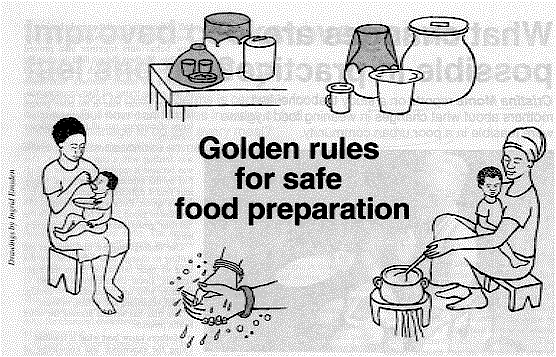
Cook food thoroughly
Raw foods are often contaminated with organisms that can cause illness. Raw poultry,
seafood, milk and vegetables are particularly risky. Thorough cooking will kill harmful
organisms. All parts of the food must be heated until they are thoroughly hot. Liquids
should be heated until they start to boil. Avoid storing cooked food
Prepare fresh food for infants and young children for each meal and give it to them as
soon as it is cool enough to eat. It is best not to give infants and young children food
that has been previously cooked and stored. But if this is necessary, food should only be
stored until the next meal. Stored food should kept as cool as possible, preferably in a
refrigerator. Stored food must be reheated until it is thoroughly hot before serving. Avoid contact between raw and cooked food
Cooked food can become contaminated by contact with raw food (e. g. hands spreading germs
from raw food to cooked food. or cooked food being placed on a surface where raw food has
been sitting). This is particularly a problem with poultry. Hands and utensils should be
washed after touching raw food. If cooked food does come into contact with raw food. it should be thoroughly re-heated. Wash fruits and vegetables
Raw fruit and vegetables should be washed carefully with clean water. If they are going to
eaten raw, they should be peeled. This is particularly important when fruit and vegetables
are likely to be heavily contaminated. e. g. if human faeces were used as a
fertiliser.
Fruit and vegetables that cannot be peeled should be cooked before being eaten. Avoid raw
fruit or vegetables that have been cut open and displayed on stalls where they may be
exposed to flies. Use safe water
It is important to use water from a safe source (e. g. a borehole) in preparing food if
this food is not going to be cooked (e. g. water used to dilute cooled gruels). If this
water is stored in the home before use, it should be kept in a clean, covered container. Wash hands Wash hands thoroughly using soap, mud or ashes before starting to prepare or serve food.
Wash hands again if you are interrupted during food preparation. e. g. after going to the
toilet, cleaning a baby or touching an animal. Avoid using feeding bottles
Use a spoon and cup to give liquids to infants. Spoons, cups. dishes and utensils used for
feeding infants should be washed with soap, mud or ashes after use. Bottles and teats are
very difficult to keep clean. If it is impossible to avoid using them, wash and boil them
after every use. Keep surfaces clean
Surfaces used for preparing food should be kept absolutely clean. Scraps of food and
crumbs can provide a breeding ground for germs and attract insects or animals. Rubbish
should be covered and be disposed of quickly. Protect food from insects, rodents and other animals
Keep animals away from food preparation areas and cover food if it is waiting to be
served. Store food in sealed containers in secure places where animals, including rodents,
cannot reach it. Store foodstuffs in a safe place
Store non-perishable foodstuffs in closed containers away from harmful substances e. g.
chemicals. Adapted from WHO's Golden Rules for Safe Food Preparation,
(In WHO Technical Report Series, No. 785).
|
|
DDOnline Dialogue
on Diarrhoea Online Issue no. 56 March-May
1994  3 Page 4 5 3 Page 4 5
What changes are possible in practice? Cristina Monte reports on a study that
consulted mothers about what changes in weaning food hygiene were feasible in a poor urban
community.
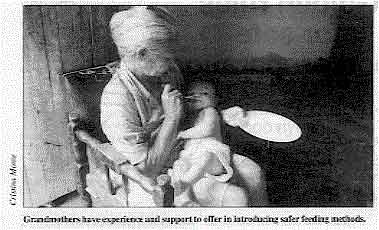 |
Grandmothers have experience and support to offer in
introducing safer feeding methods. While we have some knowledge about
practices that contaminate food, much less is known about how to change behaviour so that
contamination is reduced.
|
The challenge is to find which harmful practices can be changed. and how. Our study took place in an urban resettlement community on the outskirts of
Fortaleza,
a major city in north-east Brazil. In 1987 the infant mortality rate in the region was one
in ten live births; with half these deaths associated with diarrhoea. By interviewing mothers of infants and observing what they did at home, we identified
key behaviours likely to increase the risk of contamination of weaning foods.
- 95 per cent of mothers did not wash their hands before preparing and giving infants food
even though all households had soap and water.
- Nearly all mothers used plastic feeding bottles that were neither washed with soap nor
boiled before use.
- Water stored overnight in unhygienic conditions was commonly used to prepare milk
formulas or gruels without boiling it.
- Storing prepared milk and gruels at room temperatures for later use was common.
We found that mothers who worked outside the home were more likely to keep food and
re-use it for a second meal. Four changes in behaviour were chosen for a one-month household trial.
- washing hands before preparing food
- boiling water for mixing powdered milk
- feeding gruel with a cup and spoon rather than a bottle
- feeding only freshly prepared milk and gruel
The reasons for selecting these changes as priorities were: they addressed common
unhygienic practices; the changes were likely to reduce rood contamination; and they were
identified by mothers as possible to put into practice. Fifteen mothers who did not already practise these behaviours were assigned to each of
the four trial groups. A fifth group of mothers was encouraged to practise all four
behaviours. All the mothers were asked to assess together with the researchers how
possible it was to introduce each recommendation. and to advise on how to improve the
educational messages. The trial showed that all the behaviour changes were feasible. Most mothers continued
to practise the new behaviour throughout the one-month trial, and at least half of them
practised the new behaviour at every feeding. The introduction of all four new behaviours
together also proved possible. Mothers did not find the changes too overwhelming - each
change helped reinforce the others. Mothers' motivation in the group trying all four
recommendations was greater than in the other groups because they felt pride in meeting
the challenge of carrying out all four behaviours correctly. The most difficult behaviour to promote was feeding with a cup and spoon. This was
because it requires more time and effort by the mother, and bottle-fed babies may find it
difficult to adjust to being fed with a spoon. Even so, most mothers (53 per cent in group
3, and 60 per cent in the 'all four' group) managed to do it at every meal. Our findings suggest that mothers are willing to change their behaviour for the sake of
their infants if given the right support. Local culture gives respect to mothers who are 'ciudadosa'
- loving, careful, organised and willing to learn. The trial has several lessons for other health projects.
- Mothers know best what is feasible
Using the experience and knowledge of mothers is crucial to achieving behavioural change.
Mothers can give a realistic picture of life inside their homes and are good judges of
what changes will work, and whether some changes will place too great a burden on their
workload.
- Do not try to change practices associated with strong beliefs
When a suggested improvement clashes with a mother's beliefs it is better to abandon it.
Try to find a more acceptable alternative that will achieve the same effect. For example,
mothers strongly believed that storing water overnight was necessary to release 'the sun's
heat'. The project did not try to change this, but instead encouraged mothers to boil
water for mixing powdered milk to be added to gruels.
- The richest resource is mothers' potential
Mothers' abilities to ensure that their infants grow up healthy and strong are clearly
valued in many cultures. Health workers in other countries need to find out local beliefs
(such as 'cuidadosa') that can be promoted to encourage women' s potential.
Dr Cristina Monte, Dr Marilyn Nations, Unidade de Pesquisas
Clinicas, Faculdade de Medicina, Universidade Federal do Ceara, CP 3229,
Porangabussu, CED 60414, Fortaleza, Ceara, Brazil.
|
|
DDOnline Dialogue
on Diarrhoea Online Issue no. 56 March-May
1994  4 Page 5 6 4 Page 5 6
Improved cookstoves save fuel and money
Cooking food to destroy germs is central to food hygiene. But how can families in
areas of fuel shortage manage to do this every meal? Peter Wattsdescribes some options. Most households in developing
countries cook on an open fire surrounded by three large stones on which cooking pots are
balanced. The fuel is usually wood, waste products of crops (such as straw and maize cobs)
or animal dung. The three-stone fire uses fuel inefficiently and gives off a lot of smoke. Another common fuel is charcoal, used mainly in urban areas of Africa. While charcoal
is cleaner and bums more efficiently than wood, traditional methods of charcoal production
are very inefficient, and felling trees for charcoal contributes significantly to
deforestation. In most developing countries, fuel is becoming scarce and costly. Women have to walk
further to collect fuel or spend more money buying it. In some cases, the fuel to cook a
meal may cost more than the food. Families may try to save fuel by changing how or what
they cook. There are reports of families opting for less nutritious foods that can be
cooked more quickly or cooking in bulk and eating the same food over several meals. As a
result, nutrition and food hygiene suffer. The amount of fuel needed in traditional fires can be reduced by shielding the fire
from wind, extinguishing it after use and putting lids on pots. However, alterations in
stove design can achieve greater savings. In the past 20 years improved stove programmes have been introduced in many
developing countries. The development agency, Intermediate Technology, has been working
with local people in designing and promoting improved stoves. Two of its most successful
programmes are a charcoal stove project in urban Kenya, and a wood stove promotion in
rural Sri Lanka. Ceramic charcoal-burning stove
In towns and cities in Kenya women traditionally cook on a charcoal-burning stove
called ajiko, made of thin sheet-metal. It is low-cost but inefficient because most of the
heat is lost through the thin metal. It is also unsafe - the metal becomes very hot and
the balance is not stable. The jiko does not last long before needing replacement.
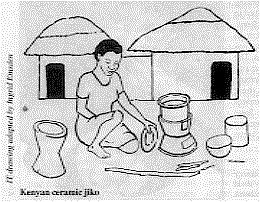 |
Kenyan
ceramic jiko
The traditional jiko is now being replaced by the Kenyan ceramic jiko
(KCJ) which was
adapted from a stove used in Thailand. The KCJ has a ceramic liner made from a mix of baked clay and rice-husk ash. The liner
fits into a metal cladding made by traditional metal workers from steel recycled from oil
barrels.
|
The ceramic liner stops the heat from escaping and the shape (wide at the base, narrow
at the grate, and wide at the top) ensures that the maximum amount of heat is directed to
the cooking pot. A door in the base allows the user to control the flow of air to the
fire. The KCJ is also more stable than the traditional stove. Although it costs about twice as much as the traditional
jiko, the KCJ soon pays for
itself in fuel savings and durability. Wood-burning stove
In Sri Lanka, Intermediate Technology has been training rural potters to make an
improved wood stove called the Anagi. It consists of two cylinders on which to
place pots, connected by a tunnel. The stove is often installed in a mud surround which
helps to retain the heat inside the stove. The design ensures that the maximum heat is
directed onto the cooking pots and enables two pots to be cooked at once.
|
Anagi wood stove
Surveys have shown that many cooks using the Anagi choose to use the saved fuel for
additional cooking, for example, boiling water when they would not normally do so. In a
country where half of the Health Department's budget is spent on combating water-borne
diseases, this is a major advance.
|
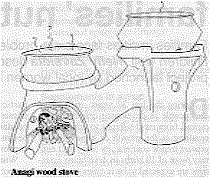 |
The Kenyan ceramic jiko and the Anagi are just two examples of improved cook-stoves
which are being used successfully in many countries to improve fuel efficiency, decrease
women's workload and reduce the time they are exposed to harmful smoke. Peter Watts, Intermediate Technology, Myson House, Railway Terrace, Rugby CV21 3HT,
UK. Resources:
Stove News, published by the Foundation for Woodstove Dissemination (FWD), is a free
newsletter promoting the exchange of information about improved cookstoves. Write to: FWD,
PO Box 30979, Nairobi, Kenya. Boiling Point is published three times a year by Intermediate Technology and
contains regular updates about improved stove technology. A year's subscription costs
£12; however a limited number of free subscriptions are available to people in developing
countries. Write to: Intermediate Technology, 103-5 Southampton Row, London WC1B
4HH, UK.
|
|
DDOnline Dialogue
on Diarrhoea Online Issue no. 56 March-May
1994  5 Page 6 7 5 Page 6 7
Addressing urban families' nutrition
Families in cities face extra problems in feeding their children well. Nelly
Zavaleta describes a self-help project launched by local women in Peru's
capital. During the last 30 years, millions of
people in developing countries have moved from rural villages to urban areas, resulting in
the growth of huge cities. If present trends continue, by early next century 6 out of 10
births in developing countries are expected to be in cities. Although people move to cities in search of better opportunities. fast-expanding urban
settlements are unable to meet the increased demand for housing, food, health services and
education. Many of the new city dwellers settle in shanty towns where they face poor
nutrition and high rates of infectious diseases. In many rural areas even very poor families can grow their own food and are usually
able to eat reasonably well, except in times of crisis such as drought. However in cities,
diet depends almost entirely on family income. Poor people in cities are particularly at
risk of low intake of micronutrients (key vitamins and minerals needed by the body to
function well) because the best sources are usually expensive (e. g. meat and fish). Women who move to cities often lose the support of the extended family who provide
advice and encouragement about breastfeeding and good weaning practices. In addition, urban women usually work long hours in workplaces where they cannot take
their infants. This often means they stop breastfeeding early and can result in inadequate
weaning practices - key factors that increase the risk of diarrhoea. Because of lack of time for cooking, urban women may buy processed food with less
nutritional value than cheaper, more nutritious alternatives such as fresh vegetables,
beans and cereals. In many cities facing these problems, poor urban communities have organised themselves
to improve their health and nutrition. Community kitchens in Lima, the capital of Peru,
are a good example of urban self-help. Fifteen years ago, in response to sharp rises in
food prices, groups of women joined together to provide low-cost, nutritious meals for
their families. The kitchens proved so popular that by 1990 more than 7,000 had been set
up. Most of the kitchens are managed by local women trained in health and nutrition. Women
whose families use the kitchens are required to carry out tasks such as buying or
preparing food, cleaning or administration. Health education centres
As well as helping families to solve their food shortages, the community kitchens also
provide advice and nutrition education. In many cases, the kitchens have become centres
for promoting children's and women's health. They are also a good source of group support
- for example. providing childcare services. Health and development organisations have become involved in supporting community
kitchens, by providing food aid and setting up health education or health care projects
based at the kitchens (see below). Dr Nelly Zavaleta, Instituto de Investigación Nutritional, PO Box 18-0191, Lima 18,
Peru.
Providing more than just low-cost food
|
Many children in Lima's shanty towns eat their best or only
meal of the day at community kitchens.
The international NGO, CARE, has actively
supported community kitchens in shanty towns in Peruvian cities over the past five years. By providing food aid and funding for operating costs, CARE strengthens local
organisations which have established community kitchens. In the kitchens volunteer women
take it in turn to cook nutritious low-cost meals for sale to local people. Community
members who clearly cannot afford to pay are given free meals.
|
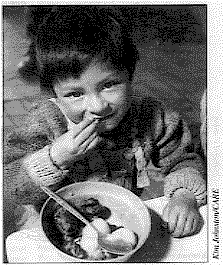 |
But the project does much more than provide low-cost food. It also funds training
programmes to upgrade the skills of kitchen managers and workers. The training covers
management of community kitchens, income generation and how to integrate health education
into the work of the kitchens. In many kitchens, women volunteers who have attended this training are now teaching
other mothers about good diets, food hygiene, sanitation, disease prevention and control,
and the use of natural medicines for first aid. Oral rehydration units in which trained women provide advice about managing and
preventing diarrhoea have been established in a number of community kitchens. Increasingly, involvement in community kitchen projects has broadened women's horizons.
The experience has taught many volunteers that they can contribute to the development of
their communities. As one volunteer commented: 'We know we have gained experience and we
are not going backwards. We will achieve more in the future.'
|
|
DDOnline Dialogue
on Diarrhoea Online Issue no. 56 March-May
1994  6 Page 7 8 6 Page 7 8
Zinc-diarrhoea link
Swapan Roy and Andrew Tomkinsdiscuss the important role of zinc in building resistance to and recovery from
infections such as diarrhoea.
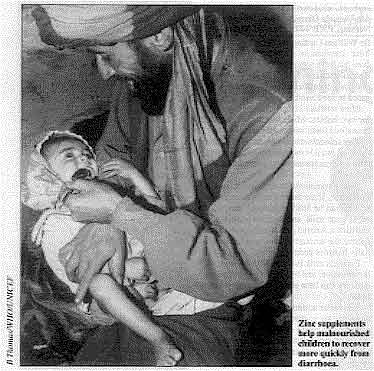 |
Zinc supplements help malnourished children to recover more
quickly from diarrhoea. Zinc is one of the many micronutrients our
bodies require in small amounts in order to stay healthy. Children need zinc to grow and
develop normally, as well as to fight infections and repair damaged tissue. Zinc is also
necessary for the lining of the intestine to function well. In addition, zinc plays a
special role in enabling the body to use vitamin A, another key micronutrient which
increases children's ability to fight infection (see="dd53.htm">DD53).
|
Recently zinc has also been found to be crucial in enabling malnourished children to
recover from diarrhoea. The best sources of zinc are meat, fish, and breastmilk since zinc
is easily absorbed from these foods. Cereals also contain zinc, but it is more difficult
for the body to absorb zinc from cereals. People who mainly eat cereals, with few other
sources of nutrients, risk developing zinc deficiency. It is particularly a problem in
areas with zinc-deficient soil, such as places where floods are frequent, because cereals
grown in this soil contain little zinc. Even in communities where regular diets include food rich in zinc, infections can cause
zinc deficiency. People with diarrhoea excrete zinc in their stools, often losing many
times their daily intake of zinc. Malnourished children with diarrhoea, especially those
with marasmus or kwashiorkor, are often lacking in zinc. Zinc is also lost as a result of
tissue damage in infections that cause fever. It is difficult to measure how much zinc people have in their bodies because this
changes over the course of an infection. Some of the following conditions may indicate
zinc deficiency:
- poor growth
- less resistance to infection
- poor inflammatory response to infection
- thinning of, or damage to, the intestinal epithelium (lining)
- excessive fluid loss during diarrhoea
- skin problems.
However zinc deficiency can occur without any clinical signs. Supplements in syrup
Studies on giving zinc supplements to treat children who have diarrhoea and protein
energy malnutrition (PEM) - those who are less than 70 per cent of the normal weight for
their age - have shown that extra zinc results in reduced stool volume and a significant
decrease in the duration of diarrhoea. It also lessens the extent of damage to
malnourished children's intestines. It is particularly effective if malnourished children
have persistent diarrhoea (diarrhoea lasting 14 days or more). Supplements can be given in the form of zinc acetate syrup mixed with a locally
produced syrup to mask the bitter taste of zinc acetate. The dose given in different
studies was between 5-15mg of zinc acetate per kilogram of bodyweight a day (divided into
two daily doses) for 14 days. This is equivalent to about 4mg/ kg/ bodyweight per day of
elemental zinc. It is also important to continue breastfeeding infants with diarrhoea because
breastmilk is rich in zinc. Similarly, children should continue to be fed during diarrhoea
and receive more food than usual during the recovery period. More work needs to be done into the role of zinc in speeding the recovery of
maInourished children from diarrhoea, but enough is already known to recommend giving them
zinc supplements, particularly when diarrhoea has lasted 14 days or more. Preventing zinc
deficiency by promoting a good, varied diet is also vital. Dr Swapan K Roy and Professor Andrew Tomkins, c/o ICDDR( B), GPO Box 128, Dhaka
1000, Bangladesh.
Further reading: Roy S K, et al., 1992. Impact of Zinc Supplementation on Intestinal Permeability in
Bangladeshi Children with Acute Diarrhoea and Persistent Diarrhoea Syndrome. Journal of
Pediatric Gastroenterology and Nutrition. 15: 289-296. Tomkins, A, et al., 1992. The role of zinc and vitamin A deficiency in diarrhoeal
syndromes in developing countries. Proceedings of the Nutrition Society 52: 131-142.
|
|
DDOnline Dialogue
on Diarrhoea Online Issue no. 56 March-May
1994  7 Page 8 7 Page 8
Exclusive breastfeeding views...
...A letter in DD54 suggested health
workers should take account of strong community views about infant feeding practices when
promoting exclusive breastfeeding. However, I am absolutely dogmatic about breastfeeding.
We should not bow to 'community opinion' when it harms the health of children. In Turkey
community opinion and wrong practice, more than poverty, is responsible for the high child
death rate. Dr Kadir Tugcu, MEDITEM, Bagdat Cad, No. 347, Erenköy 81070, Istanbul, Turkey.
.. Any group of people need to be educated before they accept new ideas such as
exclusive breastfeeding. Good health cannot be achieved if health workers do not challenge
harmful traditional beliefs. Should health workers not give children fish, meat or eggs just because these foods are
traditionally taboo for children? Should we stop promoting condoms for safer sex if men
are traditionally reluctant to use them? Patrick Johnny, Dispensing Technician, Sonnie Pharmacy and Clinic, Njama-Kowa via
Mano, Sierra Leone.
. . .I feel it is best to discourage the giving of unnecessary fluids or medicines as a
general principle. If we accept community opinion on this, it could encourage a dangerous
trend. Although castor oil may be harmless, it is impossible to know what other medicines
families will give infants, in what quantities and for how long. Most people do not have access to information about good hygiene. Therefore giving
fluids other than breastmilk can expose babies to dangerous germs. Natal K Nkulu, Makiungu Hospital and Midwifery Training School, PO BOX 56,
Singida,
Tanzania.
Milk for motherless infants
In many developing countries, maternal deaths as a result of childbirth are increasing.
So is the incidence of infants being abandoned by mothers who cannot afford to bring them
up. We all know that breastmilk is best for babies, but in cases where infants are orphans,
what can be done? Alo Victoria Olamide, Osun School of Nursing, PMB 4405,
Osugbo, Nigeria.
Dr William Cutting replies:
Your question is important. If an infant does not have a mother, then the safest and
best solution is to find another woman who is already breastfeeding who would be prepared
to feed another infant. Most mothers can produce enough milk for two babies. Many mothers
with twins breastfeed them without difficulty. This solution may not be acceptable in all
cultures, but it is more likely to be accepted if the woman is a relative of the mother
who has died. Safe alternatives to breastmilk can be expensive. If no human milk is available,
infants can be fed with animal milk. Cow milk, goat milk and buffalo milk are all
nutritious. Animal milk should be boiled to reduce the amount of curd and kill potentially
harmful germs. Formula milk is another alternative, but is expensive, and hygienic preparation and
delivery can be a problem in many households. It is better to feed a child using a spoon and cup, or a special open feeding cup,
rather than a bottle. Bottles and rubber teats are very difficult to keep clean, whereas
cups and spoons can be washed and cleaned more thoroughly.
|
Readers' information needed for mailing list update
AHRTAG is in the process of updating its mailing list for Dialogue on Diarrhoea and
its other primary health care publications. Every year hundreds of newsletters are
returned to us because readers have moved address and have not informed us. As a first step towards ensuring our mailing list is more accurate, we are sending
questionnaires to people who receive 20 copies or more of the newsletter, or who have been
on our mailing list for four years or more. If you are one of the readers who has received a yellow card questionnaire (inside the
envelope containing the previous issue of DD) or a distribution survey, please
answer the questions and return it to us as soon as possible. The yellow card and the survey also give you the opportunity to tell us about your
occupation, workplace, and what use you make of DD. This will help us to plan
newsletter content to better suit your needs. It would also be helpful if other readers who have been on the mailing list for several
years, but have not contacted us recently, would write and provide us with more
information about themselves. Please begin the letter with the heading: mailing list
information appeal. Thank you.
|

Scientific editors Dr Katherine Elliott and Dr William Cutting
Executive editor Kate O'Malley
Managing editor Kathy Attawell
Design & production Ingrid Emsden Editorial advisory group
Professor A G Billoo (Pakistan)
Professor David Candy (UK)
Dr Shanti Ghosh (India)
Dr Michael Gracey (Australia)
Dr Adenike Grange (Nigeria)
Dr Nicole Guérin (France)
Dr Norbert Hirschhorn (USA)
Dr Sharon Huttly (UK)
Dr Claudio Lanata (Peru)
Dr Jon Rohde (USA)
Dr Mike Rowland (UK)
Professor Dang Duc Trach (Vietnam)
Professor Andrew Tomkins (UK) With support from AID (USA), Charity Projects (UK),
Ministry of
Development Cooperation (Netherlands), ODA (UK), UNICEF, WHO Publishing partners
BRAC (Bangladesh)
CMAI (India)
CMU (China)
Grupo CID (USA)
HLMC (Nepal)
lmajics (Pakistan)
National Institute of Hygiene and Epidemiology (Vietnam)
ORANA (Senegal)
RUHSA (India)
Turkish Medical Association (Turkey)
Consultants at University Eduardo Mondlane (Mozambique)
|
Issue no. 56 March - May 1994
Page Navigation
This edition of Dialogue on Diarrhoea Online is produced by Rehydration Project. Dialogue on Diarrhoea was published four times a year in English, Chinese, French, Portuguese, Spanish, Tamil,
English/Urdu and Vietnamese and reached more than a quarter of a million readers worldwide. The English edition of Dialogue on Diarrhoea was produced and distributed by Healthlink Worldwide. Healthlink Worldwide is committed to strengthening primary health care and
community-based rehabilitation in the South by maximising the use and impact
of information, providing training and resources, and actively supporting
the capacity building of partner organisations. - ISSN 0950-0235 Reproducing articles
Healthlink Worldwide encourages the reproduction of
articles in this newsletter for non-profit making and educational uses. Please
clearly credit Healthlink Worldwide as the source and, if possible, send us a copy of any uses made of the material.
|
updated: 4 March, 2016
updated: 4 March, 2016
|